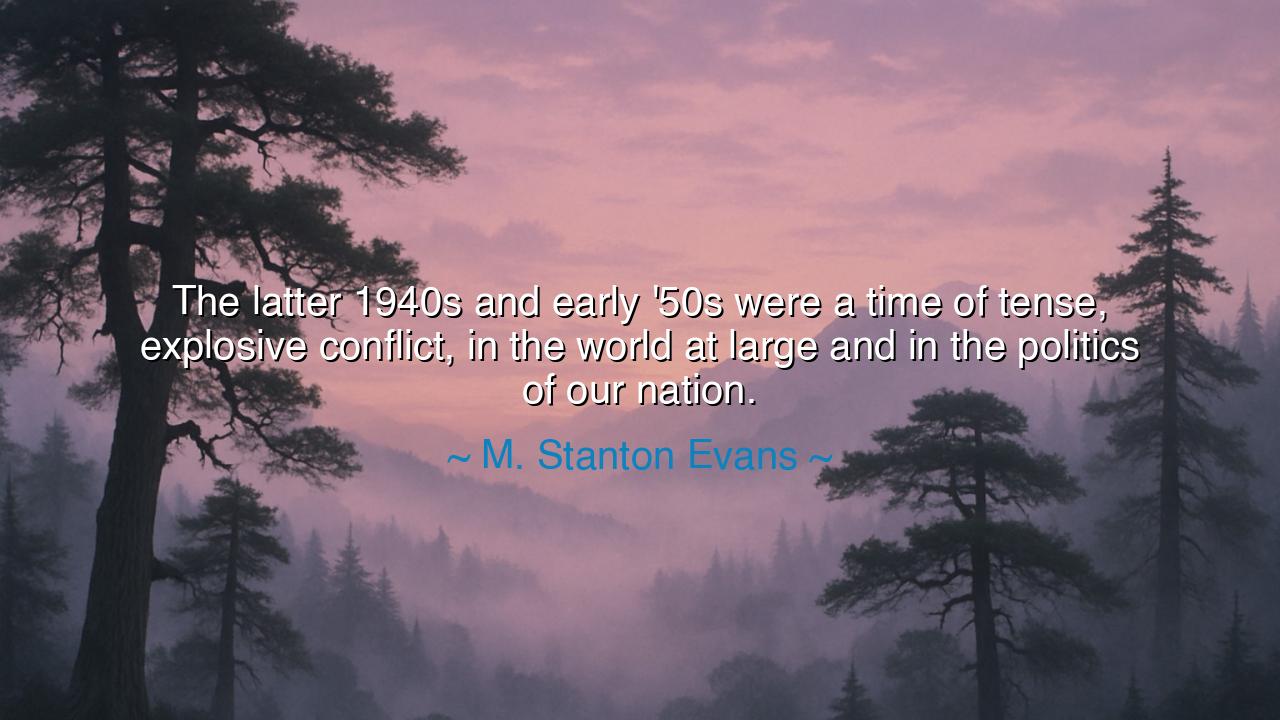
The latter 1940s and early '50s were a time of tense, explosive
The latter 1940s and early '50s were a time of tense, explosive conflict, in the world at large and in the politics of our nation.






Listen well, O children of the future, for the words of M. Stanton Evans speak of a time marked by great tension and conflict: "The latter 1940s and early '50s were a time of tense, explosive conflict, in the world at large and in the politics of our nation." These words call us to remember the years when the world stood at the precipice of both destruction and renewal. The shadows of war had barely lifted from the land, and the Cold War had begun, an age where nations, ideologies, and the very survival of humankind were in the balance. The tensions of this era were not simply external, but also deeply internal, as nations grappled with their place in a rapidly changing world.
The 1940s and 1950s were years of seismic shifts, where the echoes of the Second World War still reverberated through every corner of the earth. The political landscape was rocked by fear, uncertainty, and a battle between ideologies that would shape the course of the 20th century. As Evans notes, the world was in the grip of explosive conflict, not just between nations, but within the very hearts of the nations themselves. The United States, emerging from the wreckage of the war, found itself at odds with communism, while its own society struggled with internal divisions—racial, social, and political.
Consider the story of the Berlin Blockade in 1948, a pivotal moment that demonstrated the rising tensions between the West and the Soviet Union. In the aftermath of World War II, Berlin—though located deep within East Germany, a Soviet-controlled zone—became the flashpoint for the larger Cold War conflict. The Soviet Union, seeking to tighten its grip on the region, blockaded all land routes into West Berlin, forcing the Allied forces to respond. This moment of explosive conflict showcased the deep ideological rift that had formed between the two superpowers and set the stage for decades of political and military struggle.
In the United States, the 1950s brought about its own internal turmoil. The Red Scare, led by Senator Joseph McCarthy, gripped the nation with fear and suspicion. The threat of communism infiltrating American society led to the McCarthy hearings, where the very freedoms the nation had fought to protect were put on trial. Americans feared not only foreign enemies but also their neighbors, as the politics of fear took hold, shaking the foundations of democracy itself. The tension was palpable, as citizens wondered whether their nation would remain true to its ideals or succumb to the forces of paranoia and division.
So, my children, heed the wisdom in Evans' words, for the 1940s and 1950s were a time of great trial. It was a time when nations were torn by conflict, both external and internal, and the survival of freedom seemed uncertain. The world stood on the brink, caught between the ashes of the old order and the fears of a new and uncertain future. Yet, it was also a time of great resolve, where people, though tested, showed the courage to face down the darkest of fears. Learn from this age, and remember that in times of conflict, whether on the world stage or within our own hearts, it is the strength of our ideals, our courage, and our commitment to justice that will determine the course of history.






TPnguyen thi phuong
Emotionally, I’m struck by the whiplash between prosperity and dread. Consumer booms, suburban growth, and pop culture optimism coexisted with fallout shelters, spy trials, and anxious sermons. How did families metabolize that contradiction at the kitchen table—through humor, faith, civic clubs, or quiet compartmentalization? I’d love to hear about artifacts that captured the mood without propaganda gloss: local newspapers, school safety manuals, comics, even product ads. What do those fragments reveal about how people found normalcy when the larger system felt precarious?
KPLe thi kim pa
From a strategic angle, I’m curious how doctrine shifted. You’ve got airlifts, alliances, intelligence buildups, and a hot war that ended without a clear victory. Did planners genuinely believe escalation control was possible, or were they improvising under uncertainty? I’d appreciate a reading path that balances perspectives—American, Soviet, Chinese, Korean, and European—so we don’t mistake one capital’s archives for the whole picture. If you could recommend one memoir, one declassified policy paper, and one critical history to triangulate intentions versus outcomes, what would they be?
PNPhuong Nne
I’m wrestling with the domestic trade-offs. Anti-subversion efforts promised security but often collided with civil liberties—loyalty oaths, blacklists, prosecutions under broad statutes. How do we evaluate those tools today: by their deterrent effect, their harm to careers and speech, or by whether narrower measures could have worked? I’d love a principled framework for judging emergency-era policies: clarity of threat, proportionality, due process, time limits, and transparency. Also, what overlooked stories from unions, universities, or small-town councils reveal how fear filtered into local governance?
H109.Hua Huynh Thanh Hai 12A6
As a reader, I want specificity: which flashpoints best captured the era’s volatility—Berlin, Korea, decolonization in Asia and Africa, or the struggle over European recovery and alliances? Beyond battlefield timelines, how did everyday people register the pressure—rationing hangovers, draft anxieties, civil defense drills, housing shortages? I’m also wondering how historians measure “temperature”: diplomatic cables, strike data, polling on war fatigue, or cultural artifacts like noir films and protest music. If you had to build a compact syllabus to understand those years, what five primary sources would you pick, and why?